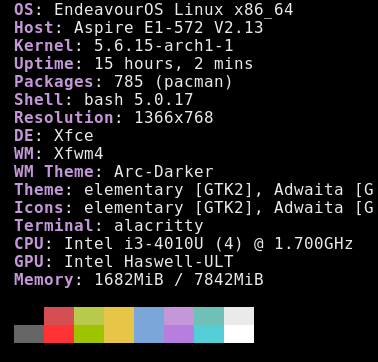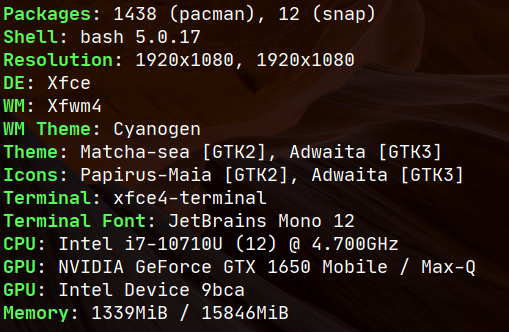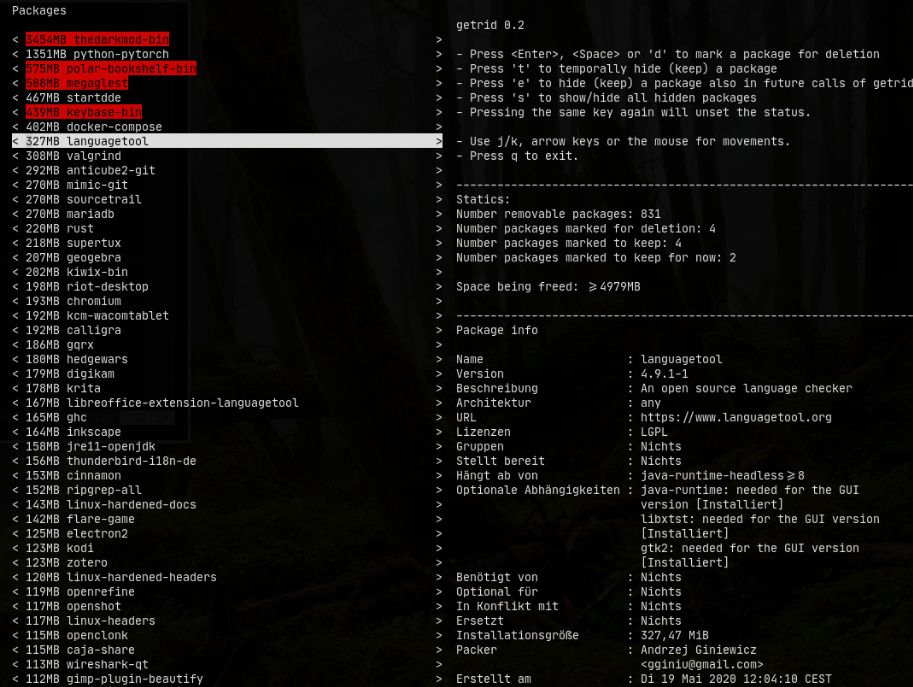Hi there, loving endeavouros, I am interested in slimming down xfce, i was wondering how i could go about this, where to start.

showing 785 packages installed
Nice to meet also younger Linux users here ![]()
![]()
OS: garuda Linux x86_64
Kernel: 5.6.15-zen2-1-zen
Uptime: 6 hours, 40 mins
Packages: 1383 (pacman) <---------- :-)
Shell: zsh 5.8
Resolution: 3840x2160
WM: i3
Theme: Layan-dark [GTK2/3]
Icons: Tela-dark [GTK2/3]
Terminal: xfce4-terminal
Terminal Font: Source Code Pro 16
CPU: Intel i7-3770K (8) @ 4.100GHz
GPU: NVIDIA GeForce GTX 1060 6GB
Memory: 7810MiB / 15956MiB
But why? ![]() Having 785 packages is very sane with a full DE…
Having 785 packages is very sane with a full DE…
hi tasia, so you are saying for complete desktop experience, leave things as they are?
the reason i asked was I often wonder if there are packages I do not need, less packages, less to update. I do like to experiment. Last week I tried pcmanfc instead of thunar, foolishly I removed thunar and its dependancies, I lost right click options on desktop. I googled doing this, and there were obviously some instructions missing.
Well, I am far from being a DE expert, but there are many parts that depend on each other and if everything works and storage space is not a concern I’d leave things as they are.
785 packages is not much and is absolutely normal (even minimal) for a DE. I have 826 with a minimal Plasma, having just a few apps.
You can try to re-install removed packages with sudo pacman -S --needed xfce4 xfce4-goodies if you are willing to install Thunar again.
Otherwise, maybe some XFCE users will jump in and give a better advice on how to make this working again.
That’s a pretty skinny system already.
Check this out for comparison:

And it’s only handpicked stuff that I use daily or needed at some point or another.
Slim it down some more and you start losing out basic functionality. Unless you have very limited storage space, I’d say having the default XFCE packages installed won’t hurt the system, as they’ll have resources allocated to them only when in use.
I’d be curious to see the memory footprint of your system right after boot (without anything open, as for example browsers tend to eat up copious amounts of memory).
In case you wonder, launch htop and see what takes up memory or CPU time on the system.
In any case you’d only be worried about memory if you run into out-of-memory situations.
Here’s the stats of thunar on my system:

As you can see the background service of Thunar is taking up 27MB of memory and barely any CPU time.
I’m not really sure what is required to switch out thunar for something else and still keep the system fully functional, but removing packages will bring you no benefit in terms of performance.
I just need to add:
Slimming down the system might be a fun goal for a PC enthusiast, but if you only plan to work on that PC and are worried about performance, I’d say you could see the time invested in that put to better use, as it won’t really make a difference.
If you’d like to tinker to get the maximum of performance out of that machine, you could check out and optimize your TLP profile (as it looks like you are using a laptop, or at least a machine with a mobile processor) and make sure you are using the machine’s total potential when on AC power (EOS ships a power-saving oriented default config for mobile devices), maybe also apply some undervolting and potentially get up to a 10% CPU boost.
Not saying these actions are needed, but it will give the geek in you some more lucrative goals ![]()
It depends what your goal is of slimming down the system.
- If your goal is to make you system run more efficiently or consume less memory, removing packages won’t help much. Instead focus on what is consuming system resources.
- If your goal is to save disk space, focus on big applications and/or kernels. That being said, there are probably better ways to reduce disk space usage.
- If your goal is reduce update bandwidth by having less packages to download, to avoid update complexities or you just like having less packages then here are some ideas:
- Remove orphans -
yay -Rns $(pacman -Qtdq) - Go through the whisker menu and remove any software you aren’t using any more
- Take a look at the optional dependencies you have installed -
comm -12 <(pacman -Qq | sort) <(comm -23 <(expac "%o" --listdelim "\n" | sort | uniq) <(expac "%E" --listdelim "\n" | sort | uniq))
- Remove orphans -
That being said, if you want to get hardcore about it and have the true minimal number of packages you are better off building up in a minimal way rather than stripping down.
You can also use, if you know what you are doing, getrid which lists all the uninstallable packages sorted by the amount of space that is freed when uninstalling them.
It is in AUR: https://aur.archlinux.org/packages/getrid-git/
https://github.com/Nudin/getrid

This one-liner can also provide more information, it shows the list of foreign packages ordered by their compilation dates, making it easier to detect suspiciously old ones.
Requires installing extra/expac
pacman -Qmq | xargs expac --timefmt='%Y-%m-%d' '%b %n' | sort
I show mine:
$ pacman -Qmq | xargs expac --timefmt='%Y-%m-%d' '%b %n' | sort
2020-05-25 cnijfilter-common
2020-05-25 milcheck-bin
2020-05-25 spotify-dev
2020-05-29 imagewriter
2020-05-31 getrid-git
$
quick reply, thanks very much for your suggestions, advice, I will take my time and have a look at all of your suggestions, thanks again
expac is a great utility, definitely worth installing. I’d also add -e and -t options to pacman to make sure that the packages were explicitly installed and not required by anything else and maybe the size of install to expac. Something like:
pacman -Qmetq | xargs expac -t '%Y-%m-%d' '%b %m %n' | sort | column -tN "Date,Size,Name"
Doesn’t that depend on the kernel and hardware? Does EOS do something special?
$ pacman -Qmetq | xargs expac -t '%Y-%m-%d' '%b %m %n' | sort | column -tN "Date,Size,Name"
Date Size Name
2020-05-25 270475670 spotify-dev
2020-05-25 533984 cnijfilter-common
2020-05-25 752040 milcheck-bin
2020-05-29 230800 imagewriter
2020-05-31 9088 getrid-git
2020-06-01 234400596 etcher-bin
![]()
I’m not really sure, I don’t think so. The TLP config files define the power-governor and the settings for that governor. Not sure if that is hardware dependent more than checking if it’s a mobile device or not. All I know is that I tested on a machine and installed both EOS and Manjaro, and Manjaro installs with different governor settings for the same hardware. Which leads me to believe it is a config file the distro maintainers edit to their liking to have a sensible default in place.
To be honest, I think a slimmed-down xfce is called Openbox. I moved from xfce a few months ago because Openbox offers the opportunity to have only the programs that you want. Sometimes, people add more and more into Openbox until it looks like xfce again. Pointless! Try Openbox with tint2, thunar (or pcmanfm), vim and firefox and work from there.
openbox is not an option with endeavouros? or have they added to live installer?
I want to stay with this distro, its the best, cannot understand how this distro is not higher in distrowatch rankings
It’s relatively new, compared to other distros. Only one year old.
It will get there, it’s filling a big empty niche with great feedback. Only a matter of time.
But if you look in distrowatch at the distros that are ahead of EOS, I’d say EOS is in pretty respectable company there. We’re talking million users distros with years and years of history. Not to mention it’s about to overtake Arch itself ![]()
I did a new install to sort out my mess up with removing thunar and losing right click desktop options, I removed firefox, transmission, parole, and a couple of others. I added gimp, alacritty, neofetch, gufw, chromium, oh and hblock (don’t really know whether hblock is necessary)
784 packages in total. I copied a couple of useful aliases from this forum and added them to .bashrc, so getting there. I chose chromium because I use google sheets for home accounts which I can share with my window using wife. also chromium saves all my bookmarks etc when I sync in settings, useful when i was moving distros a lot, I think I have found my distro for the longterm, wish there was some way of promoting endeavouros, its a perfect solution for me, thanks for all your help once again